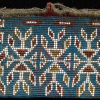Relatives/Heritage items
Displaying 201 - 220 of 4694 Relatives
Browsing allows you to see all the records for relatives and heritage items in the GKS. You can also search by material made, and/or filter by nations. To search by material made, type the material's name, by example 'leather', in the box below and click “Apply.” You can select multiple nations from the dropdown list by pressing “Ctrl” (on PC) or “Command” (on Mac) and clicking, then select “Apply.”
beaded bag, Seneca, 1840-1860.
beaded bag, Seneca, 1840 - 1860s, New York.
cigar case, moosehair embroidery, part of Lorette (Wendake) souvenir arts tradition, 1858 onwards.
A mid-nineteenth century beaded bag, Hodenosaunee or possibly Mi\'kmaq or Maliseet, acquired by Eugene Thaw from William Channing, Santa Fe
Dolls, Hodenosaunee, 1870-1880.
This ancestor is a twined bag, made from nettle fiber, wool, yarn and buffalo hair. Presenting natural fibered colour, with black and orange yarn, one side of this item presents picture languages of four hourglass-shaped thunderbirds, or animikiig, describing oral histories and stories, or aadizookaanags
This ancestor is a twined bag, made from cotton twine and wool yarn, presenting an hourglass shaped thunderbird or animikiig, and two underwater panthers or mishibizhiig, on the reverse side. The sides of this bag contain vertical geometric designs with a red, yellow, and black
This beaded charm bag is made from glass beads, nettle fiber, and yarn. Presenting a blue background with red, white and yellow beads, this ancestor is patterned with crosses and stars that have eight points on them. These points are geometrically shaped through triangles and
This twined bag, or as also referred to as a medicine bundle container, is made up from twined nettlestalk fiber, wool, yarn, and potentially buffalo hair. This finger woven ancestor used to contain medicine bundles, and comes with a buckskin tie. One side is thematic
This ancestor is a woven bag, made from nettle fiber and commercial yarn. This bag is decorated with four animal designs, woven in black thread. Alongside these, vertical stripes of red and black can be found. On the reverse side there is a webbed pattern
A Haudenosaunee/Hodenosaunee chatelaine bag with beaded floral designs. This type of bag was popular during the 1850s and third quarter of the 19th century. Currently held at the Cambridge University Museum of Archaeology and Anthropology.
A pair of mid-19th century Haudenosaunee/Hodenosaunee moccasins. The linear beadwork patterns resemble the patterns on Seneca linear beaded bags and the Seneca items documented by Lewis Henry Morgan in the 1840s to 1850s. The collection history is unknown. Presently in the collection of the Cambridge
 Knowledge Sharing Platform
Knowledge Sharing Platform







